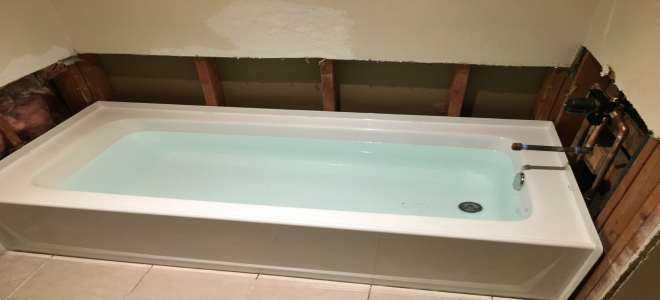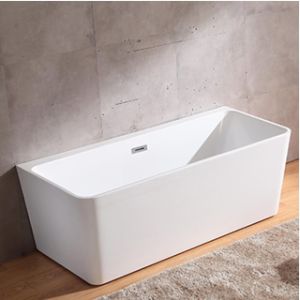Can I Set Up a Tub Myself? Considerations And Also Steps
Can I Set Up a Tub Myself? Considerations And Also Steps
Blog Article
They are making a few good points relating to How to Install a Bathtub: Install an Acrylic Tub and Tub Surround in general in this article followed below.

Setting up a bath tub isn't exactly brain surgery, yet it does require solid plumbing, woodworking, and also occasionally, tiling skills. Replacing an old bathtub with a new one is likewise a reasonably hard task. If the old bathtub is conveniently accessible, the project can relocate easily; if you need to open up a wall surface to remove the old tub as well as position the new tub, the job is a lot harder. In either case, the project is within a house handyman's abilities, although you will certainly require an assistant to leave the old bathtub as well as embeded in the brand-new one. Make certain you have actually certified on your own for the work and also are comfortable attempting it. As opposed to working with a contractor to take over a halfway-completed job, it is much better to consider employing one before you begin. Possibilities are you might require an expert plumber to make tube links.
This post will certainly aid you mount a brand-new bath tub in your washroom if you have actually currently acquired a new tub as well as don't need to alter the plan of your previous supply of water pipes.
Your tools and material list need to consist of the following:
Removing Old Touches
If you require to replace old taps with brand-new ones as a part of your setup, then the first thing you should do is detach the supply of water. After doing so, turn on the faucets to drain pipes any type of water continuing to be in the system. The procedure of eliminating the existing taps can be quite bothersome because of the restricted access that is usually the instance.
Make use of a basin wrench (crowsfoot spanner) or a tap tool to reverse the nut that links the supply pipes to the taps. Have a cloth all set for the staying water that will come from the pipelines. Once the supply pipelines have actually been eliminated, use the same tool to loosen the nut that holds the faucets onto the bath/basin. You will require to stop the solitary taps from transforming during this procedure. When the taps have actually been removed, the holes in the bath/basin will certainly have to be cleansed of any type of old securing substance.
Before moving on to fit the new faucets, contrast the pipeline connections on the old faucets to the new faucets. If the old taps are longer than the brand-new taps, after that a shank adapter is required for the brand-new taps to fit.
Fitting New Touches
If the tails of the new faucets are plastic, then you will certainly need a plastic adapter to avoid damages to the thread. One end of the adapter fits on the plastic tail of the tap and also the other end supplies a connection to the existing supply pipelines.
If you need to fit a monobloc, then you will certainly require lowering couplers, which connects the 10mm pipe of the monobloc to the common 15mm supply pipe.
Next off, position the faucet in the installing hole in the bath/basin ensuring that the washers remain in location in between the tap and also the sink. Protect the faucet in place with the supplier offered backnut. As soon as the tap is firmly in place, the supply pipelines can be connected to the tails of the faucets. The faucets can either be connected by utilizing corrugated copper piping or with regular tap adapters. The former kind should be linked to the faucet ends first, tightening up only by hand. The supply pipes can later on be connected to the various other end. Tighten both ends with a spanner after both ends have been attached.
Installing the Tub
Making use of the two wooden boards under its feet, position the bath tub in the required setting. The wood boards are useful in uniformly spreading out the weight of the bathtub over the location of the boards as opposed to focusing all the weight onto four little factors.
The following goal is to ensure that the bath tub is leveled all round. This can be achieved by checking the spirit level as well as readjusting the feet on the bath tub until the spirit level checks out level.
To set up faucets, fit all-time low of the furthest versatile tap port to the proper supply pipeline by making a compression join; then do the exact same for the various other faucet.
Activate the water supply and inspect all joints as well as brand-new pipework for leakages and tighten them if required. Fill the tub and likewise inspect the overflow electrical outlet as well as the regular outlet for leaks.
Lastly, take care of the bathroom paneling as defined in the maker's user's manual. Tiling and also securing around the bathtub should wait until the tub has been utilized at the very least when as this will certainly resolve it right into its last position.
Preparing for the Installation
Firstly, the supporting frame supplied with the bath ought to be fitted (if needed) according to the producer's directions. Next, fit the taps or mixer to the tub. When fitting the tap block, it is necessary to make sure that if the faucet features a plastic washing machine, it is fitted in between the bathroom and also the faucets. On a plastic bathroom, it is likewise practical to fit a supporting plate under the taps unit to prevent strain on the tub.
Fit the versatile tap connectors to the bottom of the two taps using 2 nuts and also olives (occasionally provided with the tub). Fit the plug-hole outlet by smearing mastic filler round the sink electrical outlet opening, and after that pass the outlet via the hole in the bathroom. Utilize the nut supplied by the manufacturer to fit the plug-hole. Examine the plug-hole electrical outlet for an inlet on the side for the overflow pipeline.
Next off, fit the end of the flexible overflow pipe to the overflow electrical outlet. Afterwards, screw the pipe to the overflow face which ought to be fitted inside the bath. Ensure you use every one of the provided washers.
Link the trap to the bottom of the waste outlet on the bath tub by winding the string of the waste electrical outlet with silicone mastic or PTFE tape, as well as screw on the trap to the outlet. Attach all-time low of the overflow tube in a similar manner.The bath should currently prepare to be fitted in its last placement.
Tiling Around the Tub
In the area where the bathroom satisfies the tile, it is essential to secure the joins with a silicone rubber caulking. This is important as the fitting can relocate sufficient to break an inflexible seal, triggering the water to penetrate the wall surface in between the bath and also the tiling, resulting in complications with wetness as well as feasible leakages to the ceiling listed below.
You can choose from a selection of coloured sealers to blend in your components and installations. They are offered in tubes and also cartridges, and can sealing voids up to a width of 3mm (1/8 inch). If you have a bigger gap to load, you can fill it with spins of soaked paper or soft rope. Keep in mind to constantly fill up the bathtub with water prior to sealing, to enable the movement experienced when the bathtub is in usage. The sealer can crack rather early if you do not think about this movement prior to sealing.
Additionally, ceramic coving or quadrant tiles can be made use of to edge the bathroom or shower tray. Plastic strips of coving, which are easy to use and reduce to dimension, are additionally quickly readily available on the market. It is a good idea to fit the tiles utilizing waterproof or water resistant sticky and grout.
Bathtub Installation
How Important Is A Bathtub To Your Home?
High-quality baths, showers, and other bathroom updates are necessary when considering a smart investment in your home. It’s a room that you go to every day and one that is constantly being used by guests.The bathroom is one of the top trafficked rooms in a home and also one of the most valuable in terms of home resale.
Install Piping Before Tub
You will be using your existing drain and waste vent system, but pipes required include the hot and cold water supply lines and a pipe leading to a shower head. A mixing valve and shower head are also needed. Air chambers may be required.
Position the Tub
Lower the tub into place so that the continuous flange fits against the wall studs and rests on 1’x4' or 2’x4' supports. Anchor the tub to the enclosure with nails or screws inserted through the flanges into the studs.
NOTE: Remember, bathtubs and shower stalls may require support framing. A bathtub filled with water is extremely heavy, so check building codes and framing support before installing the tub.
Assemble Drain Connections
Assemble the bathtub drain connections by connecting the tub overflow with the tub drain above the trap, not beyond it. The trap will have a compression fitting that screws over the arm of the overflow assembly.
Place a Pipe For the Shower Head
First, locate a brass female threaded winged fitting and attach it to a framing support via a screw or a nail. Then run a pipe up the wall for the shower head. Sweat or solder the other side of the brass fitting to the top of the pipe.
Attaching Hot and Cold Water Lines
Attach your water lines for both hot and cold by sweating these directly into the hot and cold ports of the mixing valve. The mixing valve will be how water enters the tub’s system, not by the pipes themselves.
Install the Spout
Extend a piece of 1/2 inch pipe, or whichever length is specified in the manufacturer’s instructions, for the tub spout. Sweat on a male threaded fitting at the end of the pipe or use a brass nipple of the proper length and a 1/2 inch cap.
NOTE: At this point you should have your rough-in plumbing work inspected before proceeding further.
Check For Leaks
Restore the water pressure and check the drain connection and the supply pipes for any sign of leaking.
estore the Bathroom Wall
Replace the wall with moisture-resistant drywall as a base for your wall covering. Seal the joints between the wall and your new tub with silicone caulk as protection against water seepage.
https://www.berkeys.com/2016/12/02/bathtub-installation-dallas/

We are very focused on How to Install a Bathtub: Install an Acrylic Tub and Tub Surround and I hope you enjoyed reading the piece. Are you aware of somebody else who is fascinated with the subject? Why not promote it. Thank-you for your time invested reading it.
Schedule Service Now
Report this page